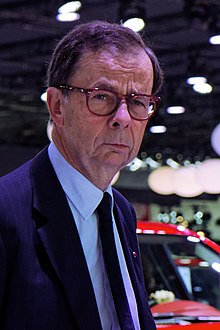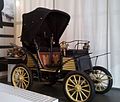The Cars PortalA car, or an automobile, is a motor vehicle with wheels. Most definitions of cars state that they run primarily on roads, seat one to eight people, have four wheels, and mainly transport people rather than cargo. There are around one billion cars in use worldwide. The French inventor Nicolas-Joseph Cugnot built the first steam-powered road vehicle in 1769, while the Swiss inventor François Isaac de Rivaz designed and constructed the first internal combustion-powered automobile in 1808. The modern car—a practical, marketable automobile for everyday use—was invented in 1886, when the German inventor Carl Benz patented his Benz Patent-Motorwagen. Commercial cars became widely available during the 20th century. The 1901 Oldsmobile Curved Dash and the 1908 Ford Model T, both American cars, are widely considered the first mass-produced and mass-affordable cars, respectively. Cars were rapidly adopted in the US, where they replaced horse-drawn carriages. In Europe and other parts of the world, demand for automobiles did not increase until after World War II. In the 21st century, car usage is still increasing rapidly, especially in China, India, and other newly industrialised countries. Cars have controls for driving, parking, passenger comfort, and a variety of lamps. Over the decades, additional features and controls have been added to vehicles, making them progressively more complex. These include rear-reversing cameras, air conditioning, navigation systems, and in-car entertainment. Most cars in use in the early 2020s are propelled by an internal combustion engine, fueled by the combustion of fossil fuels. Electric cars, which were invented early in the history of the car, became commercially available in the 2000s and are predicted to cost less to buy than petrol-driven cars before 2025. The transition from fossil fuel-powered cars to electric cars features prominently in most climate change mitigation scenarios, such as Project Drawdown's 100 actionable solutions for climate change. (Full article...) Entries here consist of Good and Featured articles, which meet a core set of high editorial standards.
 The Holden Commodore (VE) is a full-size car that was produced from 2006 to 2013 by Holden—the Australian subsidiary of General Motors. Dubbed Holden's "billion dollar baby", the car was available as the Holden Berlina—the mid-range model—and the Holden Calais, the luxury variant; utility body styles were marketed as the Holden Ute. Succeeding the VZ series, the VE was the first iteration of the fourth generation of the Holden Commodore, a series of automobiles built between 1978 and 2020. Unlike its predecessors, which used Opel-sourced platforms adapted to mechanics and sizes that would suit the local market, the VE was the first Commodore entirely designed and developed by Holden in Australia. To minimise export redevelopment costs, features, such as a symmetrical centre console housing a flush-fitting hand brake lever, facilitated the conversion to left-hand drive. The VE was internationally badge-engineered as the Chevrolet Lumina, Chevrolet Omega, Bitter Vero Sport and Pontiac G8. (Full article...) Selected article -The Huning Highlands Conoco Service Station is a historic gas station in the Huning Highlands neighborhood of Albuquerque, New Mexico. It was built in 1937 by the Continental Oil Company (Conoco) and is notable as a well-preserved example of the automobile-oriented development that shaped the city during the mid-20th century. The building was listed on the New Mexico State Register of Cultural Properties and the National Register of Historic Places in 2006. The service station is built in the form of a cottage, a popular design at the time, with a steeply pitched compound gable roof and a chimney. The walls are white glazed brick with green trim. The building has a side-gabled office section on the west side adjoining two front-gabled garage bays with wooden roll-up doors. The easternmost garage bay was an addition built onto the original station around 1939. The property also includes concrete gas pump islands, a c. 1960s light pole and a steel sign post, though the pumps, tanks, and signage have been removed. The station was operated by Conoco until 1961, then by Horn Oil Company until around 1983. In 1992, the vacant station was leased by the Albuquerque Conservation Association (TACA), which uses the building as headquarters for its preservation workshops and other activities. (Full article...) Selected picture of the day
Selected biography -Louis Schweitzer (born 8 July 1942) is a Swiss businessman who is a former chairman of the board of Groupe Renault, first taking the post on 27 May 1992, succeeding Raymond Lévy. He was also CEO from 1992 to 2005. He was in addition Chairman of AstraZeneca until 8 June 2012 where he was appointed as a Director on 11 March 2004. He is a non-executive director of BNP Paribas, Electricité de France, Veolia Environnement, Volvo AB and L'Oréal, and Vice-Chairman of the Supervisory Board of Philips Electronics NV (Full article...) On this day February 21
Did you know...
Selected quote of the dayA car for every purse and purpose (AMG) —Alfred P. Sloan, describing the hierarchy of General Motors brands' TopicsGeneral imagesThe following are images from various car-related articles on Wikipedia.
CategoriesThings you can do to help If you wish to help, you can:
Associated WikimediaThe following Wikimedia Foundation sister projects provide more on this subject:
Discover Wikipedia using portals
|




















































































You must be logged in to post a comment.